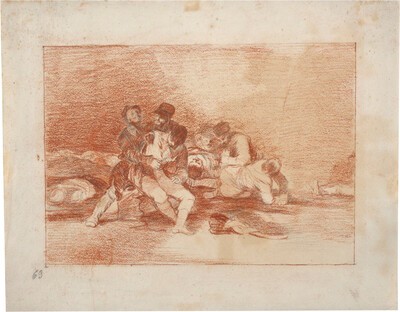- Cronología
- 1810
- Dimensiones
- 162 x 237 mm
- Técnica y soporte
- Aguafuerte, buril, lavis y bruñidor
- Reconocimiento de la autoría de Goya
- Undisputed work
- Ficha: realización/revisión
- 01 Dec 2010 / 16 Jun 2025
- Inventario
- 225
Goya 1810 (lower left-hand corner, obscured by the etched lines), 8 (lower left-hand corner).
See Sad presentiments of what must come to pass.
In the second state proof of the second etching, the original design was extensively retouched, with the area that had previously been left unworked in the foreground on the right-hand side filled in. There are some burnished foul bites visible on the figures.
The title was handwritten by Goya on the first and only print run that we know to have been made at the time, and which the painter gave to his friend Agustín Ceán Bermúdez. The title was engraved on to the copperplate at a later date, and no other modifications were made to the image for the first edition of the Disasters of War, which was printed by the Royal Academy of Fine Arts of San Fernando, Madrid, in 1863.
We can see how a correction was made to the title, adding the letter ‘y' where an ‘i' had probably been engraved initially.
This is one of the few etchings in the series, along with All this and more and Charity, to be dated by the artist.
There are two preparatory drawings for this work in the Prado Museum.
Treat them, then on to other matters depicts the treatment received by those wounded in the war. In the background we can see two men holding up a wounded soldier from behind. Slightly further back another, slumping figure is receiving aid.
The scene takes place outdoors, in daylight and, just as occurs in other etchings in the Disasters of War series, the natural environment is an inhospitable one. The trees appear barren, their branches hanging down, almost without life. Such surroundings make the ideal setting in which to stage these scenes of death and destruction.
The artist has used the etching process repeatedly, especially on the left-hand side of the print, which is visually heavier than the right-hand side. The left of the image features a dark, solid rock, which contrasts sharply with the clear sky shown on the right.
The scene is a depiction of false piety, in which the aid is not given disinterestedly, and the purpose of it is to get the injured men patched up as quickly as possible so that they can prove useful again to the war effort. Nobody appears at all interested in the corpses that we can see in the etching's background, starkly lit by Goya.
This same subject matter is addressed in other etchings in the series, including no. 24, They'll still be useful and no. 25, So will these.
La plancha se conserva en la Calcografía Nacional (cat. 271)
-
Goya and his timesThe Royal Academy of ArtsLondon1963cat. 66cat. 236
-
Francisco Goya. Sein leben im spiegel der graphik. Fuendetodos 1746-1828 Bordeaux. 1746-1996Galerie KornfeldBern1996from November 21st 1996 to January 1997cat. 108
-
Francisco de GoyaMuseo d'Arte ModernaLugano1996exhibition celebrated from September 22nd to November 17th.cat. 20
-
Francisco Goya. Capricci, follie e disastri della guerraSan Donato Milanese2000Opere grafiche della Fondazione Antonio Mazzottacat. 100
-
Goya. Opera graficaPinacoteca del Castello di San GiorgioLegnano2006exhibition celebrated from December 16th 2006 to April 1st 2007p. 61
-
Goya et la modernitéPinacothèque de ParisParís2013from October 11st 2013 to March 16th 2014cat.59
-
Goya, grabadorMadridBlass S.A.1918cat. 122
-
Goya engravings and lithographs, vol. I y II.OxfordBruno Cassirer1964cat. 140
-
Vie et ouvre de Francisco de GoyaParísOffice du livre1970cat. 1024
-
Catálogo de las estampas de Goya en la Biblioteca NacionalMadridMinisterio de Educación y Cultura, Biblioteca Nacional1996cat. 217
-
ParísPinacoteca de París2013p. 129
-
Goya. In the Norton Simon MuseumPasadenaNorton Simon Museum2016pp. 114-151


